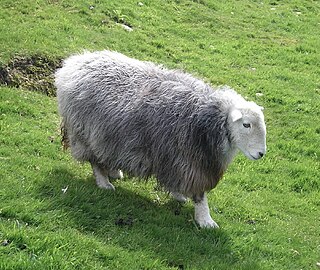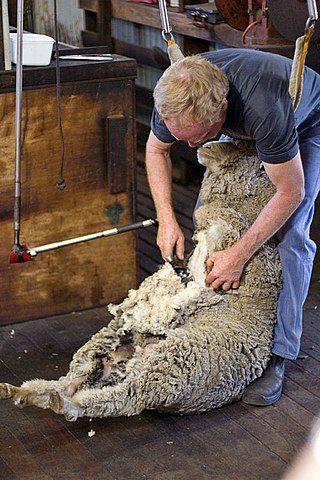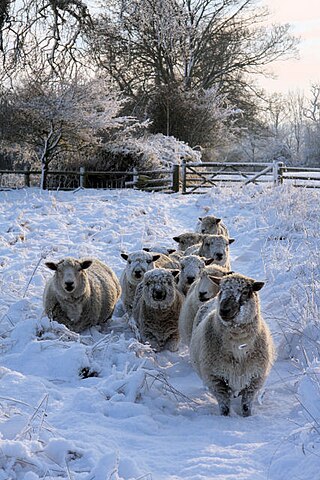
The Herdwick is a breed of domestic sheep native to the Lake District in North West England. The name "Herdwick" is derived from the Old Norse herdvyck, meaning sheep pasture. Though low in lambing capacity and perceived wool quality when compared to more common commercial breeds, Herdwicks are prized for their robust health, their ability to live solely on forage, and their tendency to be territorial and not to stray over the difficult upland terrain of the Lake District. It is considered that up to 99% of all Herdwick sheep are commercially farmed in the central and western Lake District.

Sheep farming or sheep husbandry is the raising and breeding of domestic sheep. It is a branch of animal husbandry. Sheep are raised principally for their meat, milk, and fiber (wool). They also yield sheepskin and parchment.

Sheep shearing is the process by which the woollen fleece of a sheep is cut off. The person who removes the sheep's wool is called a shearer. Typically each adult sheep is shorn once each year. The annual shearing most often occurs in a shearing shed, a facility especially designed to process often hundreds and sometimes more than 3,000 sheep per day.

The Hampshire Down or Hampshire is a British breed of sheep. It originated in about 1829 from cross-breeding of Southdowns with the Old Hampshire breed, the Wiltshire Horn and the Berkshire Nott, all horned, white-faced sheep — these were native to the open, untilled, hilly stretch of land known as the Hampshire Downs. It is much used as a terminal sire.

The Ryeland is one of the oldest English sheep breeds going back seven centuries when the monks of Leominster in Herefordshire bred sheep and grazed them on the rye pastures, giving them their name. It was introduced into Australia in 1919 and are classified as an endangered breed by the Rare Breeds Trust of Australia and also are one of the nine heritage breeds that were the foundation of the sheep and wool industry in Australia. The Ryeland was one of the breeds used to introduce the poll gene to the Dorset breed in the development of the Poll Dorset. This breed is raised primarily for meat.

The Rough Fell is an upland breed of sheep originating in England. It is common on fell and moorland farms, its distribution embracing a large proportion of South Cumbria, parts of the West Riding of Yorkshire, North Lancashire and, more recently, upland parts of Devon. It is very hardy and, as its name suggests, has proved to be well-suited to endure the hardships of exposed and high moorland and mountains. It is one of the largest mountain breeds in Britain. This breed is raised primarily for meat.

The Romney, formerly called the Romney Marsh sheep but generally referred to by the local farmers as the Kent, is a breed of sheep originating in England. The Romney is a "long-wool" breed recognized in England by 1800. Exported to other continents, the Romney is an economically important sheep breed, especially to the sheep-meat and wool export trades of New Zealand.

The Balwen Welsh Mountain sheep is one of a number of varieties of Welsh Mountain sheep, bred for sheep farming in Wales. It has a distinctive colour pattern of a black body with white extremities. It originates in the Tywi valley in Wales. This breed is raised primarily for meat.

Welsh Mountain sheep are small, hardy sheep from the higher parts of the Welsh mountains. The males have horns, and the females are polled (hornless); they have no wool on the face or legs, and they have long tails. There are a number of varieties, bred for sheep farming in Wales. These are mainly colour variations, but some are being developed as separate breeds.

The raising of domestic sheep has occurred in nearly every inhabited part of the globe, and the variations in cultures and languages which have kept sheep has produced a vast lexicon of unique terminology used to describe sheep husbandry.

The Clun Forest is a breed of domestic sheep originating from the area surrounding the Clun Forest in Shropshire, England. Similar to many of the British breeds of upland sheep, Clun Forest are hardy, adaptable, good foragers, and are long–lived. With sleek heads and wide pelvic structures, Clun Forest ewes lamb easily. The breed has a short to medium–length wool and dark brown faces. They are a multi–purpose animal, kept for meat, wool, and milk. Like other dark faced sheep, Clun produce quality lamb and mutton. However, in contrast to more common meat breeds such as Suffolks, their wool is free of undesirable black fibres and kemp, and is suitable for handspinning. The breed's alert and stylish appearance, together with its reputation for hardiness and fecundity have made it popular with hobby farmers and large commercial flock owners alike. The Official Clun Sheep Breeders Society Show & Sale for males and females is held annually in early September at Ludlow livestock market by McCartneys.

The Black Welsh Mountain sheep is a colour type of the Welsh Mountain sheep, bred for sheep farming in Wales. It occurs occasionally in flocks of other colours, but is now often maintained as a separate strain. Like other Welsh Mountain sheep it is found mainly on the hills in Wales, but is also kept elsewhere. The worldwide population of Black Welsh Mountain sheep is approximately 10000. A breeders' society for Black Welsh Mountain Sheep was formed in 1920 at the Smithfield Show.

Sheep or domestic sheep are a domesticated, ruminant mammal typically kept as livestock. Although the term sheep can apply to other species in the genus Ovis, in everyday usage it almost always refers to domesticated sheep. Like all ruminants, sheep are members of the order Artiodactyla, the even-toed ungulates. Numbering a little over one billion, domestic sheep are also the most numerous species of sheep. An adult female is referred to as a ewe, an intact male as a ram, occasionally a tup, a castrated male as a wether, and a young sheep as a lamb.

The Zwartbles is a breed of domestic sheep originating in the Friesland region of the north Netherlands. There it was primarily used for the production of sheep milk as well as lamb and mutton. They were often kept alongside dairy cattle herds.

Dre-fach Felindre is a village in Carmarthenshire, West Wales. It is located four miles south-east of Newcastle Emlyn. It lies at the confluence of three fast-flowing streams, the Nant Bargod, Nant Esgair and Nant Brân, where their steep-sided valleys open out into the Teifi Valley. In the 19th and early 20th century it was an important centre for the woollen industry and was given the epithet, "the Huddersfield of Wales". As the population increased, the villages of Dre-fach and Felindre extended and merged to form the present community.

The history of the domestic sheep goes back to between 11,000 and 9,000 BC, and the domestication of the wild mouflon in ancient Mesopotamia. Sheep are among the first animals to have been domesticated by humans. These sheep were primarily raised for meat, milk, and skins. Woolly sheep began to be developed around 6000 BC. They were then imported to Africa and Europe via trading.

Sheep farming is a significant industry in New Zealand. According to 2007 figures reported by the Food and Agriculture Organization (FAO) of the United Nations, there are 39 million sheep in the country. The country has the highest density of sheep per unit area in the world. For 130 years, sheep farming was the country's most important agricultural industry, but it was overtaken by dairy farming in 1987. Sheep numbers peaked in New Zealand in 1982 to 70 million and then dropped to about 27.6 million. There are 16,000 sheep and beef farms in the country which has made the country the world's largest exporter of lambs, with 24 million finished lambs recorded every year.

The woollen industry in Wales was at times the country's most important industry, though it often struggled to compete with the better-funded woollen mills in the north of England, and almost disappeared during the 20th century. There is continued demand for quality Welsh woollen products.

Agriculture in Wales has in the past been a major part of the economy of Wales, a largely rural country that forms part of the United Kingdom. Wales is mountainous and has a mild, wet climate. This results in only a small proportion of the land area being suitable for arable cropping, but grass for the grazing of livestock is present in abundance. As a proportion of the national economy, the importance of agriculture has become much reduced; a high proportion of the population now live in the towns and cities in the south of the country and tourism has become an important form of income in the countryside and on the coast. Arable cropping is limited to the flatter parts and elsewhere dairying and livestock farming predominate.

Cwmhiraeth is a hamlet in Carmarthenshire, Wales, contained in the Dre-fach Felindre district. While the name has no exact meaning in English, it can be roughly translated to "valley of longing". Cwmhiraeth used to be a source of activity for the textile industry, but has since declined.
























